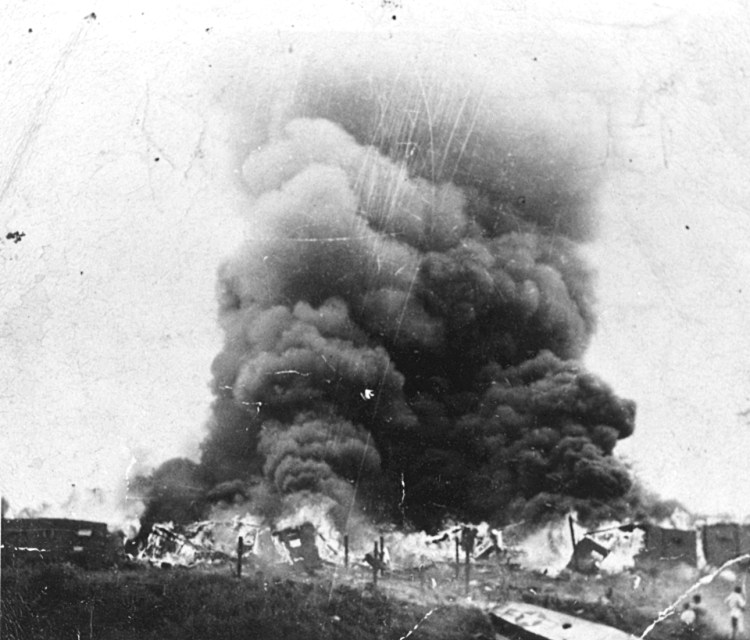
South Portland sports legend and Army Lt. Philip Russell was killed, along with 18 others, on July 11, 1944, when his A-26 Invader aircraft crashed into a trailer park near Long Creek. (Courtesy South Portland Historical Society)
The 75th anniversary of the state’s deadliest aviation disaster will pass quietly in South Portland on Thursday.
On July 11, 1944, an Army bomber banked over a trailer park near what was then known as Portland Municipal Airport. The plane hit the ground and a fireball erupted.
The pilot, Lt. Philip I. Russell, a 23-year-old South Portland native, was killed along with a flight engineer and 17 people on the ground who were residents of a trailer park built for workers at the South Portland shipyard and their families. The area is now home to Redbank Village.
Russell’s wife, holding the couple’s infant daughter, and other family members could see the explosion from the airport, where they had waited to greet Russell, who was stationed in Louisiana and was flying in to visit his family.
While it remains the worst aviation disaster in Maine history, no cause has ever been disclosed.
That’s not surprising, said Jamie Rice, director of library services for the Maine Historical Society.
With World War II still raging – the D-Day invasion of France had taken place barely a month before the crash – accidents were treated as military information that had to be withheld. The Historical Society’s records, she said, consist of the Press Herald’s coverage of the crash and a brief government report that mentions the crash but offers few details.
“It’s so contrary to the way we function in our society today,” when the public would demand an explanation, Rice said.
Maine State Historian Earle Shettleworth said the fact that hundreds were dying daily in the fighting worldwide also was likely a factor in the lack of a push for an explanation of what led to the crash.
“Particularly in modern warfare, civilian casualties are part of the equation,” he said. “This happened during the war and happened to families involved in the war effort and that’s why they were there. We should honor their memory like you would casualties of war.”
A ceremony marking the 65th anniversary of the crash was held in 2009 and a memorial now sits at the site of the crash.

Rice said the cause will likely never be determined, although more information could be available in military documents. She said documents from World War II are still being declassified and historians will likely pore over them to see if information on the cause was found at the time, but not released.
According to contemporary accounts, fog was reported around the airport during the late afternoon on July 11, 1944. Some accounts suggested that Russell’s relatives saw smoke coming from the twin engines of the light bomber, a Douglas A-26 Invader, but neither explanation proved definitive. The crash happened as Russell, who had been a star athlete in South Portland, apparently was turning back toward the airport to land.
Few survivors of the crash are still alive. One, Sandra Embrey, said she’s had a few flashbacks of the event over the years.
Embrey lived in one of the trailers with her parents and was 4 years old at the time. Her father worked at the South Portland shipyard, which primarily built ships to carry munitions and troops to Europe.
Years ago, Embrey said, she heard a plane flying overhead that sounded as if it was having engine problems.
“That plane’s going to crash like the other one,” she told the family, and then recounted her memories of a crash, a fire and her mother running with Embrey in her arms.
Embrey’s father filled her in on the details of the crash, she said. Embery, who grew up in Maine before moving to Ohio, said she still has occasional flashbacks when she hears plane engines.
The trailer park is long gone. Rice said the original plan to replace the trailers with apartments proceeded quickly after the crash. The main streets in the development – MacArthur Circle and Wainwright Circle – were named after World War II generals.
Shettleworth said a handful of communities around Portland can trace their roots to housing projects for shipyard workers, who came from throughout Maine. In addition to Redbank, there were developments at what became Sagamore Village in Portland and Ferry Village in South Portland, he said.
“Housing was at a premium and people were desperate to find just a place to sleep, really,” he said, and it wasn’t uncommon for residents to rent out a couch or a cot to a shipyard worker.
Rice said the crash was one of the few occasions when the war came to Maine, even though the link was tenuous.
“This was the only taste of this that Maine was going to experience,” she said.
Send questions/comments to the editors.



